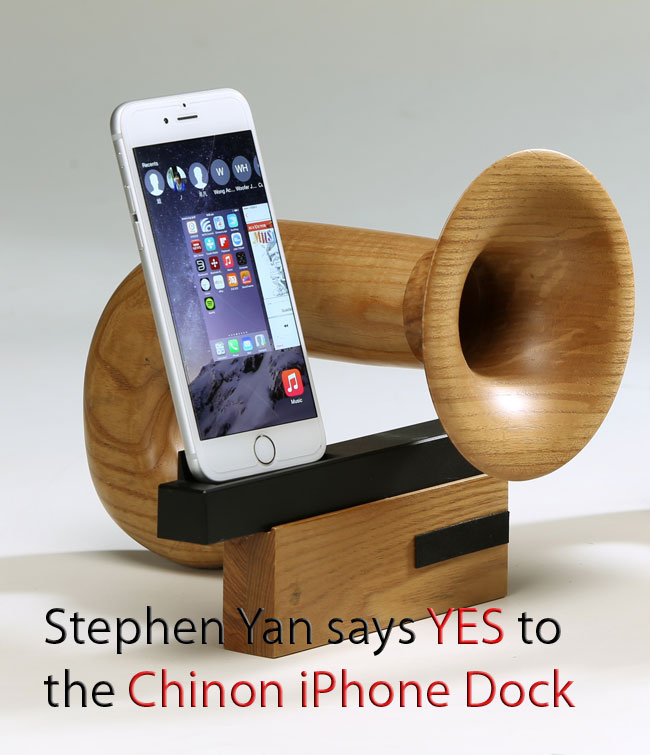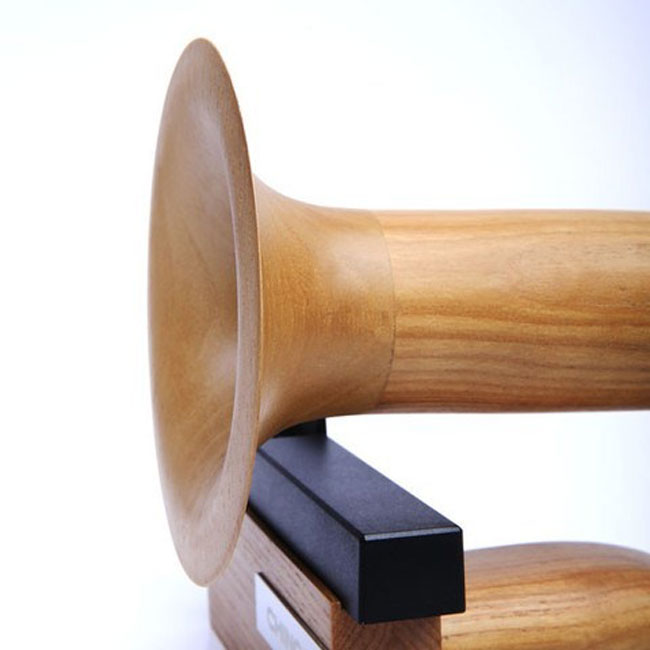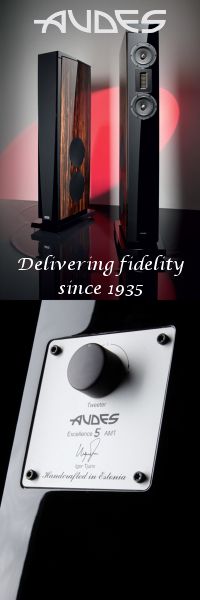CHINON IPHONE DOCK

Those of you with an iPhone, forgetting for a moment that it was meant primarily as a telephone, may have come across times when you wished you were able to just use the phone as a music player without any extraneous accessories. When you are sitting at your desk, and you just want to listen to some tunes, you don’t always want to plug in your earphones, or turn on Bluetooth and connect to some external device which you also have to turn on, and so forth. The dinky little built-in speakers make your favourite artistes sound like squeaking mice. You can’t hear your favourite lyrics. All of a sudden, that expensive device sounds like it wasn’t worth that overnight camp in freezing weather when you queued up to get it just so you could earn your bragging rights.
Then there are audiophiles. Yes, I mean you (poke). You who think that tubes are not an underground train system or an item of women’s clothing, and horns are not what grows out of the heads of some animals, or what you press when the idiot in front cuts into your lane. And God forbid when the twain shall meet (audiophiles and iPhone owners, not horns and tubes, which do meet rather regularly). When stars align and the twain do meet and mate, then the Chinon iPhone dock is a prime example of that progeny which can ensue.

Freddie Kwoh, the designer of this product, is himself a committed audiophile and an inveterate tweaker. I have written about his products in these hallowed pages before (read them here). But when he sent me this dock, I was initially reluctant to review it. As a general rule, Stereotimes.com does not review cheap consumer goods. Then I spoke to him more about it, and realized that it is not another Walmart product. It really does have audiophile roots, albeit buried deep underground and not readily apparent upon first sight. According to Freddie:
“What most people do not realize is that the speaker unit in the iPhone is a high performance unit and is capable of reproducing very high sound quality. It may not be known by many people that a small speaker unit has faster transients than a larger speaker unit due to the smaller physical weight. Our design team, after we have discovered the high performance of Apple’s speaker unit, decided to bring out the best from the iPhone using a horn concept.”
 In theory, this sounds like a perfect marriage. Take the best of new technology, pair that with the best of ancient technology, and voila, you should have a great product. This is what the Chinon team was hoping for anyway. But how serious were they when they designed this product? Freddie again:
In theory, this sounds like a perfect marriage. Take the best of new technology, pair that with the best of ancient technology, and voila, you should have a great product. This is what the Chinon team was hoping for anyway. But how serious were they when they designed this product? Freddie again:
“Different horn design approach[es] were considered, the length of the horn, the mouth to drive unit ratio, the compression chamber, the flare of the horn mouth plus many other factors. We treated this project as a Top End exotic audiophile project. A wooden horn was selected. Wood horns have particular characteristics in the mid-low and low regions and are preferred by many audiophiles. Various horn designs, such as tractrix horns, exponential horns were tried and tested and eventually we came up with a combination of these basic designs”.
Ok, they were really serious. But to be fair, the idea of combining Apple products with horn-loaded after market accessories is not a new idea. There have been any number of rubber or plastic based horn-type products for Apple iPhone or iPad speakers for some time now. In particular, I spied a rubbery add-on device for my old iPad 2 with a horn-shaped (and I use this phrase advisedly) contraption, and bought it for a lark just to see what it could do compared with the Chinon. The rubber “horn” produced that dreaded horn-smell colouration, which is ok if you are just watching YouTube videos and downloaded movies. Compared to such cheap and cheerful products, the Chinon’s fit and finish are miles ahead, and the fact that these guys have put in so much effort into a linear amplification of the original sound must at least be applauded. Whether that herculean effort turns out to be a pyrrhic victory is debatable. I think it’s touching that there are engineers out there dedicated to trying to improve all aspects of our lives however small, but it could be a lot of effort for not a very big payoff. The proof of the pudding, as they always say, is in the eating.
I do not want to go into too much detail about the design of the docking system save to note that you are given different adaptors to fit different types of iPhones, and you do not need to plug the dock into any power source. It is a pure passive product. I don’t know about you, but I get a rosy glow inside knowing that I’ve taken yet another step towards reducing my carbon footprint, however small it may be. I also like the idea that this dock is super portable and if you bring it on holiday with you, you no longer need to faff around with transformers, adaptors, cables and connectors. Just poke the iPhone into the Chinon and off you go. You can, however, plug in a USB cable to the Chinon if you wished, but that is really if you want to use the dock to charge your iPhone while listening to it. It is not required for music operation.

Sound Quality
The Chinon team, while audiophiles themselves, are realists. They know that the laws of physics are immutable. Therefore, what they set out to do was really to just boost the critical mids, and bracket that a bit both higher and lower, to give an amplification factor of about 6dB to the 150Hz to 8.5kHz region. Bear in mind that while 6dB sounds tiny, to achieve that in your real-world hifi system, you will require a quadrupling of your amplifier output!
My experience with the Chinon iPhone dock was varied. I had two minor disadvantages; one, I did not have a lot of music stored in my mobile phone as I rarely listen to music on the go. Two, I did not have an iPhone. Fortunately, my mom has an iPhone 6 and does listen to tunes on her phone, so I was able to review the Chinon using her phone.
Our experiences with tiny, products-that-do-not-look-like-they-can-blow-us-away-but-they-do components such as un-prepossessing Aktimate or Audioengine powered speakers, dinky Tripath amplifiers, and cigarette-lighter DACs like the Dragonfly or Geek Pulse, all products that punch well above their weight and price category, may have spoiled us in our expectations. The Chinon brings us back to reality. As Freddie himself admitted, this is not a product to turn a sow’s purse into a silk ear (or is the other way around? I forget). This is a passive unit, so how well it works is dependent on what is being put in in the first place. Granted, the latest iPhone speakers all now have five (instead of the previous 3) magnet transducers thus increasing sound quality. I looked through the internet and was able to find many third-party replacement loudspeakers for iPhones that range in price from $2 to $9, and some of them tout high quality sound and craftsmanship. I have no idea if these are the same exact OEM unit just rebranded by different sellers, but if I were an iPhone audio fanatic and wanted to get the best au naturel sound from my phone, I might want to just try buying the best after-market loudspeaker module I can find, and doing the replacement myself. From the pictures and YouTube videos I have seen, it does not appear to be a very complicated task. Most loudspeaker modules in the various iterations of iPhones (3 to 6) all sit on top of the docking port and require minor surgery to remove. As with all consumer products, do any modifications at your own risk and remember that your warranty will be voided if you tinker with the insides. If in doubt, get a professional to do it for you.
Anyway, back to the Chinon dock. What the Chinon will do is to faithfully reproduce its source, which is the iPhone speaker itself. I tried various kinds of music, ranging from classical to jazz to pop (sorry no heavy metal), and in all cases I found the same thing. The Chinon does what Freddie says it does, which is to amplify the driver and give you a bigger facsimile of itself. From what I could tell, that’s the sum total of its ability. Do not expect it to transform the iPhone into an Avantgarde Trio. It will not give you higher highs or lower lows. Think of the Chinon as just a magnifying glass that puts out a bigger version of what you put in, period. And if you’re ok with that, then this product does exactly that.

Conclusion
What I liked about the Chinon is its form factor, and that it is perfect for solo listening in non-critical environments such as the study, bedroom or kitchen, or even when you have a small gathering and your friends would like to share their tunes on their iPhones.
Remember though, I am not dissing the Chinon iPhone dock. It takes audiophile experience, cunning and savvy to just boost something in a linear fashion, without adding or removing anything. This is done well in the Chinon. I liked it when listening to it late at night next to my bed with gentle classical or jazz fare. It was fun to play around with when my family wanted me to hear their new favourite songs. And that wooden horn does look cool and has carries its audiophile pedigree with some pride. What’s not to like? 
stephen yan
FEATURES
Beautifully Handcrafted from Ash wood
Play direct from your iPhone speaker
Built for intimate listening experience
Recharge your iPhone
Use as hands free stand
1.5 meter USB cable included
Detachable docking to support iPhone 4, 4S
Compatible with iPhone 4, 4S, 5, 5S, 5C, 6, 6+
PRICE : $249.00 USA
Website: http://www.chinonshop.com/products/handcrafted-passive-speaker-dock-for-iphone
Stereo Times Masthead
Publisher/Founder
Clement Perry
Editor
Dave Thomas
Senior Editors
Frank Alles, Mike Girardi, Russell Lichter, Terry London, Moreno Mitchell, Paul Szabady, Bill Wells, Mike Wright, and Stephen Yan,
Current Contributors
David Abramson, Tim Barrall, Dave Allison, Ron Cook, Lewis Dardick, John Hoffman, Dan Secula, Don Shaulis, Greg Simmons, Eric Teh, Greg Voth, Richard Willie, Ed Van Winkle, Rob Dockery, Richard Doron, and Daveed Turek
Site Management Clement Perry
Ad Designer: Martin Perry





Be the first to comment on: CHINON IPHONE DOCK